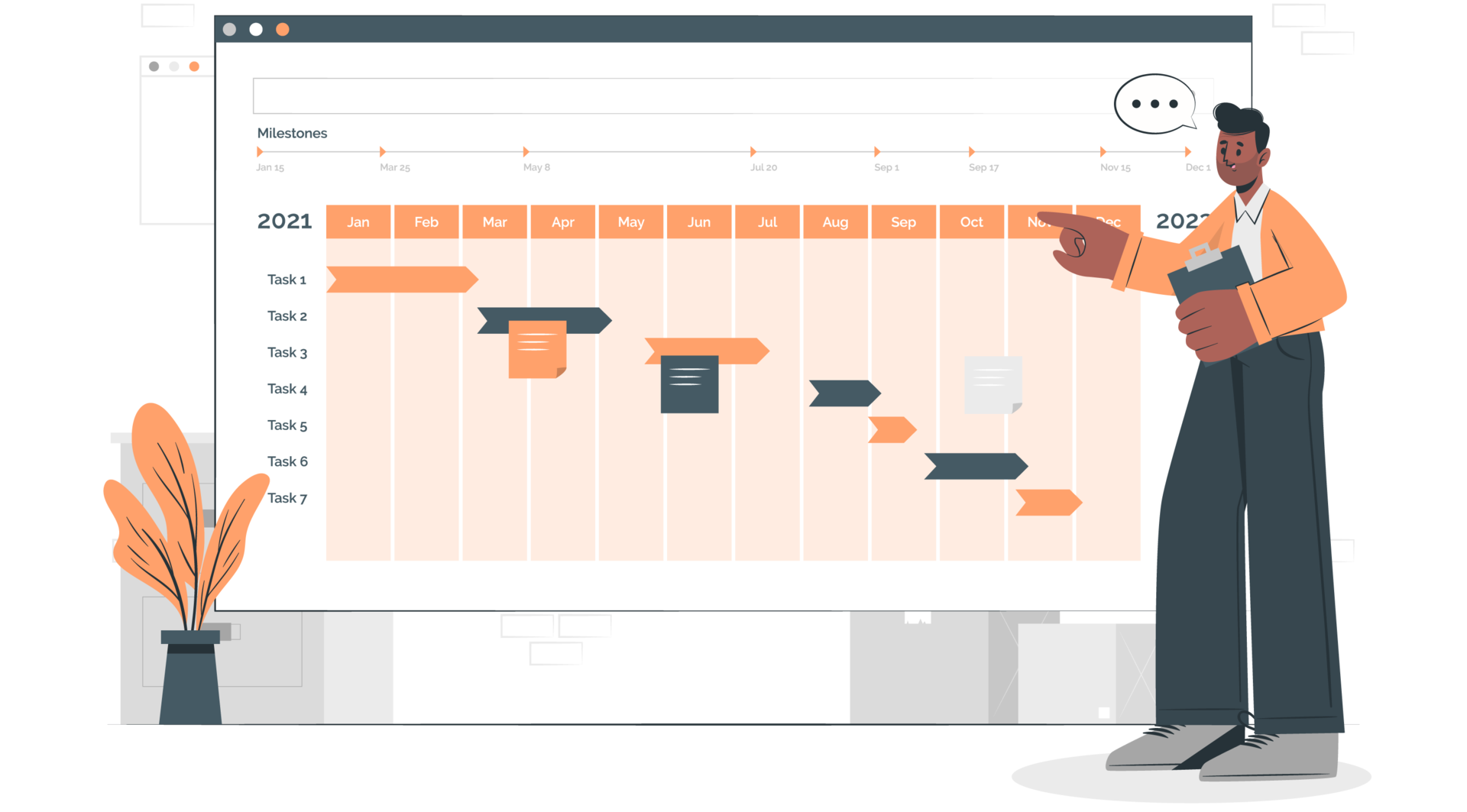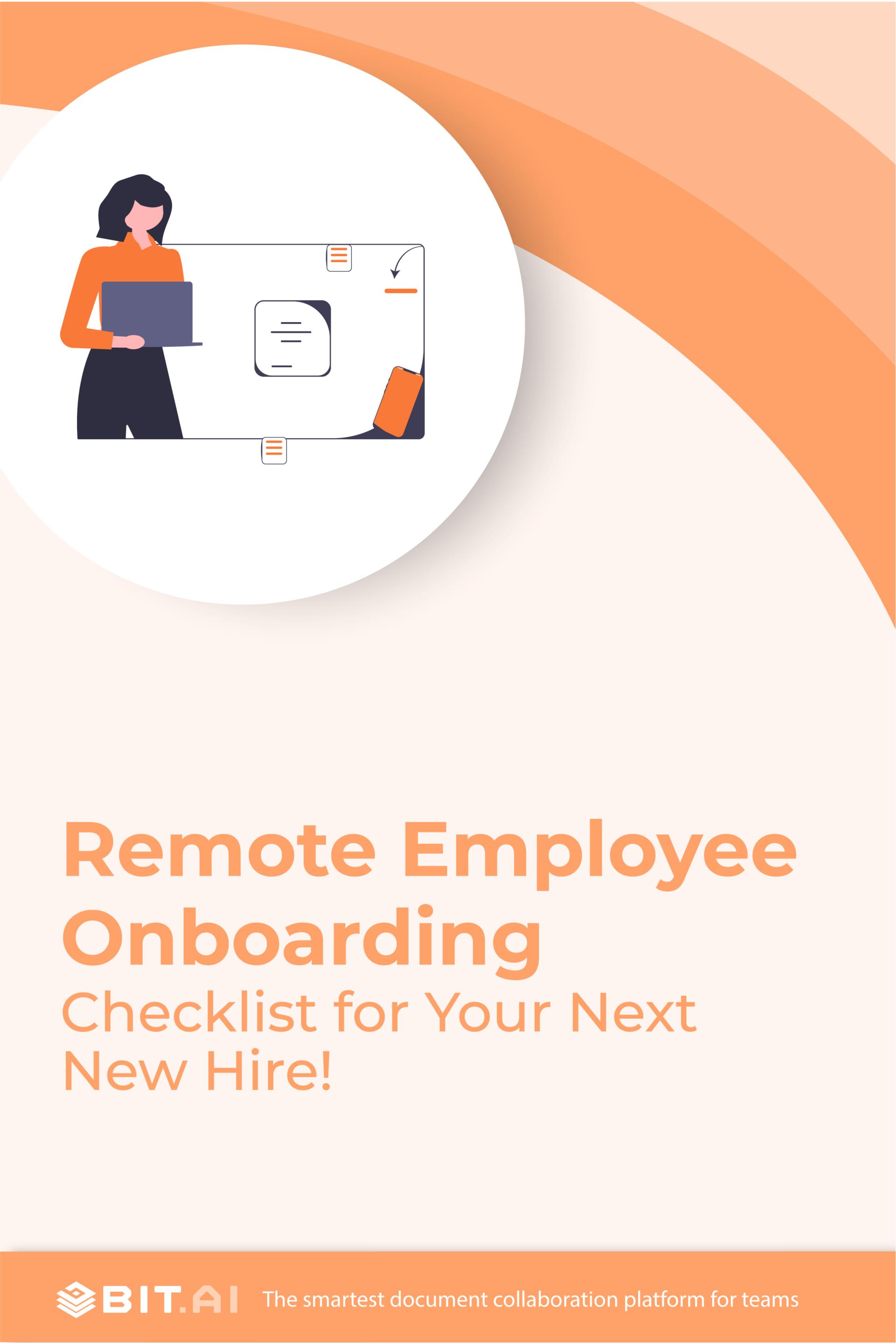Imagine you’ve just been hired by a company fully embracing remote work. You’re excited about the job, but you’re also a little nervous about how you’ll get started since you won’t be working in an office with your new colleagues. That’s where remote employee onboarding comes in.
Any company has a well-organized and structured process to ensure you have all the tools, resources, and support you need to thrive in your new role, even if you’re not physically in the same location as your colleagues.
The goal is to create a smooth transition for new hires, despite not being physically present in the same office or work location as their colleagues.
With the rise of remote work, companies need to ensure that their new hires feel welcomed and included, even working from a different timezone or country.
By the end of your remote onboarding, you’ll feel like you’re part of the team, even if you haven’t met your colleagues yet!
In this blog post, we will understand the gritty nitty of remote employee onboarding.
So, let’s get started!
Remote Employee Onboarding: Meaning
Many of us are used to traditional onboarding, where you have to attend long meetings, fill out endless paperwork, and sit through hours of in-person training. And let’s be real, that’s about as exciting as watching paint dry. But with remote onboarding, things are different.
Remote employee onboarding is integrating new hires into a company’s culture, workflow, and expectations when working remotely. It involves providing new employees with the necessary resources, information, and tools to perform their duties and feel like they’re part of the team, even if they’re working from a distance.
It is all about making new hires feel welcome and part of the team, even if they’re miles away.
Companies provide virtual orientation sessions, online training, and access to digital communication tools, so you don’t feel like you’re stranded on a deserted island. You get to meet your colleagues through video calls, and they’ll give you feedback to help you improve.
Did you know that according to a study by Click Boarding, 91% of employees who went through a structured onboarding process felt more connected to the company’s culture?
One of the coolest things about remote onboarding is how personalized it is. It’s not a one-size-fits-all kind of thing. You get to tailor it to your needs and preferences.
So if you’re a visual learner, you can watch training videos. You can practice your skills with interactive modules if you’re a hands-on learner. And if you’re a social butterfly, there are virtual team-building activities to get you connected with your new coworkers!
And let’s not forget about the time and cost savings. With remote onboarding, there’s no need for travel or in-person meetings, which means you can get up to speed on your new role faster. Plus, the company saves money on things like office space and travel expenses.
Having a good understanding of Remote Employees Onboarding, it’s time to explore how to put it into practice!
How to Onboard Remote Employees? (Best Practices)
1. Plan Ahead

When you’ve got a recruit joining the team, it is always better to plan.
It’s like they say, “Fail to plan, plan to fail.”
We want our new hires to feel welcome, appreciated, and like they’ve made the best decision by joining our team.
So, what does planning ahead mean exactly?
It means having a clear plan for the first week so your new hire knows exactly what to expect. Don’t just leave them floundering, trying to figure out what they’re supposed to do. That’s like throwing someone into the deep end without a life vest.
Plan training sessions, so they can learn the ropes of their new role. But don’t make it boring. Spice it up, make it fun and engaging, and maybe even have a game or two to break the ice.
Introduce them to the team members so they don’t feel like total strangers.
And last but not least, give them an overview of the company culture. What’s the dress code? What’s office etiquette? Let them know what’s expected of them so they don’t accidentally break unwritten rules.
So there you have it, folks. Plan and make your new hire feel like a part of the team from day one.
And remember, a little humor and personality can go a long way in making the onboarding process a success!
2. Communicate
Communication is key when it comes to remote employee onboarding. You don’t want your new hire to feel stranded on a desert island with no way of getting help.
So, let’s talk about how to communicate effectively during the onboarding process.
First, ensure your new hire knows who to ask for help. Ensure your new hire knows who to turn to if they have questions or need help. This can include their supervisor, HR representative, or a designated mentor.
But don’t stop there. It’s important to check in with your new hire regularly during their first week to ensure they’re settling in okay. You don’t want to be one of those bosses who’s always hovering, but you also don’t want to be completely MIA. Strike a balance and let your new hire know you’re there for them if they need anything!
And let’s be real; communication isn’t always easy. There can be miscommunications, misunderstandings, and the occasional awkward moment. But that’s okay! The important thing is to be willing to work through any issues that arise.
So, keep those lines of communication open, and you’ll be golden!
3. Assign a Buddy
Assigning an experienced employee is a great way to help new employees feel more comfortable in their new workplace. It’s no secret that starting a new job can be overwhelming and intimidating, especially when getting to know a new team and workplace culture.
An experienced employee can help to ease those nerves by providing a friendly face and a go-to person for questions and guidance.
From the perspective of the experienced employee, acting as a buddy can also be a rewarding experience. It allows them to share their knowledge and expertise while helping build camaraderie and teamwork within the organization.
When assigning a buddy, choosing someone who is approachable, knowledgeable, and willing to take on the responsibility is important. The buddy should be available to answer any new employee’s questions, show them around the office, and introduce them to key team members. They should also be patient and understanding, recognizing that everyone learns at their own pace.
It is also effective to train existing employees for such roles. This can include tips for effective communication, strategies for supporting new employees, and best practices for helping them to navigate the workplace.
Overall, assigning a buddy is a valuable onboarding practice that can help new employees to feel more comfortable and supported in their new workplace. It’s a simple yet effective way to build a sense of community and teamwork and can contribute to the long-term success of the new employee and the organization.
4. Offer Training
So, let’s talk about offering training to your new employees. It’s important to remember that your new hires may not know everything about your company or even their specific role, and that’s okay! That’s where training comes in.
Would you want a surgeon operating on you without knowing what they were doing? Yeah, we didn’t think so. The same goes for your new hires; they need to know the ins and outs of their role and responsibilities and how your company operates.
Try to make the training process engaging and interactive. Maybe include some group activities or hands-on learning experiences. Make it a little fun, and your new employees will be more likely to retain the information.
But don’t just stop at the initial training. Ensure to provide ongoing training and support to ensure your new hire continues developing and succeeding in their role. Hey, it’s a win-win situation! Your new hire feels valued and invested, and your company benefits from having a knowledgeable and skilled employee.
Offering training and resources to your new hires is essential to the onboarding process. Just remember to keep it engaging, interactive, and ongoing.
5. Encourage Questions

When you bring in a new employee, they will have questions. You should encourage them to ask questions and clarify that it’s a safe space.
We want to make it crystal clear that it’s okay to ask questions, and we’re here to create a welcoming environment where you can do just that. Because let’s face it, no one wants to feel like they’re drowning in a sea of confusion on their first day. Employees should feel comfortable and confident in their role, which means having all the information they need.
So how can you create an environment where questions are not only allowed but actively encouraged?
First, make sure your new hire knows who to ask for help. This could be their manager, a designated point person, or even a friendly colleague. And if you’re the manager, ensure they know you’re always available to answer their questions, no matter how big or small.
But don’t just stop there. Create a culture of curiosity and continuous learning. Encourage your team to ask questions and seek answers, whether through formal training or informal conversations. Because let’s be real, nobody knows everything, and there’s always room for growth and improvement.
So go forth and create a welcoming environment where questions are not only allowed but celebrated.
6. Set Expectations
When new employees come on board, they want to know what’s expected of them. They want to know what success looks like in their role and how they can positively impact the company.
So, you must make your expectations crystal clear from the get-go. Talk to your new hire about what they’ll be responsible for, their goals, and how they’ll be measured. It’s also a good idea to discuss any potential challenges they may face in their role and how they can overcome them.
And don’t forget to communicate these expectations early on in the onboarding process. You don’t want your new hire to be confused or unsure about what’s expected of them.
But it’s not just about setting expectations. It’s about being clear and specific. Don’t just say, “We expect you to do a good job.” That’s vague and unhelpful. Instead, be specific about what you want them to do and how you want them to do it.
For example, if you’re hiring a salesperson, you might say, “We expect you to make at least 50 calls a day and close at least 3 deals a week.” See the difference? That’s a clear expectation that your new hire can work towards.
But setting expectations isn’t a one-and-done deal. You must regularly check in with your new hire to ensure they’re on track and provide feedback as needed. And remember, it’s a two-way street. Encourage your new employee to ask questions, share their ideas, and offer you feedback.
By being clear and specific about what you expect from your new hire, you’re setting them up for success and making your life easier. It’s a win-win!
7. Continuously Improve
So, why should you bother with evaluating and improving your onboarding process?
It can help you identify areas where new hires may struggle or feel overwhelmed. Maybe your orientation sessions are too long, or your training materials are too dense. By gathering feedback from your new hires, you can make adjustments to ensure the onboarding process is effective and efficient.
But it’s not just about addressing problem areas. By continuously improving your onboarding process, you can stay ahead of the curve and keep up with evolving best practices.
What worked five years ago may not be as effective today, and by staying current with the latest trends and technologies, you can ensure that your onboarding process is engaging and impactful.
According to Business.com, companies that invest in onboarding have higher retention rates, and personalized onboarding programs can boost employee engagement and productivity.
Plus, let’s be honest, nobody likes a stagnant workplace. By improving your onboarding process, you can show your new hires that you’re committed to their success and invested in their development. This can help boost morale and retention rates, which is good news for everyone involved.
So, how can you go about evaluating and improving your onboarding process?
First, gather feedback from new hires through surveys, focus groups, or one-on-one interviews. Ask them about their experience and what could be improved.
Second, involve stakeholders from different departments in the process. This can help ensure everyone’s needs are met, and the onboarding process is aligned with company goals.
And finally, keep an eye on industry trends and best practices, and be willing to try new things.
In conclusion, continuously evaluating and improving your onboarding process is necessary for any organization that wants to set its new hires up for success.
8. Make it Personal
It’s essential to take the time to get to know your new hire personally and encourage them to share their interests and hobbies with their new colleagues. This is an excellent way to build rapport and help your new employee feel like they are part of the team.
According to Forbes, a personal touch can include sending a welcome package to the employee’s home, including company-branded items and a handwritten note from their manager.
This gesture can make them feel valued and appreciated before starting their new job. Another idea is to set up a virtual coffee chat or lunch meeting with the new hire to get to know them better and help them feel comfortable.
This could involve tailoring the training program to the employee’s strengths and weaknesses, assigning a mentor or buddy to help them navigate their new workplace, and providing regular feedback and support.
By getting to know your new employee personally, you can build a strong foundation for a positive employer-employee relationshipthat benefits both the individual and the organization.
Now that we’ve got a handle on the basics, let’s dive into the nitty-gritty with the Remote Employees Onboarding checklist.
Remote Employees Onboarding Checklist:
Remote employee onboarding is becoming increasingly popular as more and more companies shift to remote work. With the ongoing pandemic, it has become necessary for businesses to ensure that their new employees receive a smooth and successful onboarding experience, even when they are not physically present.
To achieve this, it is essential to have a remote employee onboarding checklist. This checklist serves as a comprehensive guide outlining all the necessary steps, tasks, and information that new employees need to be aware of during onboarding.
Let’s dive into a 6-step checklist that can help your remote employees achieve quick wins during their onboarding process, ensuring their success and satisfaction from the get-go:
1. Pre-Boarding Communication
Starting a new job is already stressful enough, but starting a new remote job? That’s a whole new level of uncertainty. That’s why pre-boarding communication is so important. It’s a simple way to make the new remote employee feel welcomed and comfortable before starting their first day.
So, what should you include in a pre-boarding message?
First and foremost, a warm welcome! This can include the onboarding process and a timeline; you can also provide an overview of what to expect and any necessary materials.
And don’t be afraid to get personal! Share some fun facts about the company culture or team members to help the new remote employee feel like they’re already part of the team.
But don’t stop there! Keep the lines of communication open throughout the onboarding process.
According to a survey by Gallup, employees who have regular communication with their manager are three times more likely to be engaged in their job. So, don’t be afraid to reach out and check in on how the new remote employee is doing.
In short, pre-boarding communication is a small but important step in making the new remote employee feel welcomed and supported from day one.
2. Hardware and Software Setup
You want to ensure your remote employee has all the necessary equipment to complete the job. That means a computer or laptop, a monitor, and all the other little things that make work life easier, like a mouse and keyboard.
Now, let’s move on to software. Ensure your remote employee can access all the software needed to do their job. That might include VPN software, communication tools like Slack or Microsoft Teams, document collaboration tools like Bit.ai, project management software like Trello or Asana, and email.
It’s also important to ensure your remote employee has the right permissions and access to all the necessary files and documents. You don’t want them to be stuck without access to the company drive or unable to open a crucial document.
And here’s a little fun fact according to a survey by Whatfix, 67% of employees say that accessing the necessary software and tools is the biggest challenge when onboarding remotely.
So, ensure you’re on top of your game, and your remote employee will thank you.
Related: 21 Remote Work Tools & Apps For Productive Employees!
3. Virtual Office Tour
First, you want to ensure you’ve got all the tech and software in place for a smooth virtual office tour. You don’t want to be that person who tries to give a tour only to have the video call crash mid-sentence.
Don’t forget to introduce your new remote employee to their team members and colleagues they may be working with. It’s always good to put faces to names and start building those relationships right away.
You want to ensure you’re setting your new remote employee up for success and creating an environment where they can thrive.
With some preparation and the right tech, you can make it an unforgettable experience!
4. Team Introductions

Team introduction is a crucial part of the onboarding process. They set the stage for building positive relationships with team members and creating a sense of belonging.
Your new remote employee must meet their team members and get to know their roles and responsibilities. You can schedule video calls, team lunches, or other virtual events to facilitate introductions.
It’s also essential to provide background information on each team member’s role and responsibilities. This can help the new remote employee understand the team dynamic and feel more comfortable contacting specific team members for help or collaboration.
Lastly, don’t forget to schedule follow-up meetings or virtual coffee breaks to continue building relationships with team members.
Creating opportunities for casual conversations and getting to know each other can go a long way in building a strong team dynamic and a positive work environment.
5. Training and Orientation
We all know that feeling of being thrown into the pool’s deep end without knowing how to swim. So, providing our new remote employees with proper training and orientation is crucial to help them get up to speed with the company’s policies, workflows, and tools.
One tip is to mix things up – don’t just provide boring training manuals and tutorials. Add interactive sessions and videos to make it more engaging and fun.
According to a report by SHRM, companies with a formal onboarding process have a 50% higher new-hire retention rate than those without one. So, by providing proper training and orientation, you’re not only helping your new employees, but you’re also helping your company’s bottom line.
Another tip is to have a designated person or team to handle the training process. This person should be able to answer any new employee’s questions and provide guidance throughout the process.
And let’s not forget, the training process should be ongoing, not just a one-time event. Set up regular check-ins with the new employee to ensure they adjust well to their new role and provide additional training as needed.
So, let’s ensure we give our new remote employees the tools they need to succeed.
6. Follow-up and Feedback
It might seem like a chore, but it’s an essential part of the onboarding process for remote employees. Here are some tips and examples to help you make it less painful:
Schedule Regular Check-Ins: It’s important to check in with your new remote employee regularly, especially in the first few weeks. This can be a quick 10-minute chat or a longer video call to discuss any issues, concerns, or questions they may have. You can even schedule a daily stand-up meeting to keep everyone on the same page.
Provide Constructive Feedback: It’s important to provide constructive feedback to your new remote employees so they know what they’re doing well and where to improve. Be specific and give examples, and remember always to frame it positively. For example, “You did a great job on that project, but I think we could improve on this part.”
Be Patient: New remote employees must adjust to their new role and company culture. Be patient and give them the support they need to succeed.
Conclusion
So there you have it, folks. Remote employee onboarding is rapidly becoming the new norm. It is flexible, personalized, and engaging.
But, like any other onboarding process, remote onboarding requires careful planning and execution. That’s where a remote employee onboarding checklist comes in handy.
So the next time you’re looking to onboard new employees remotely, don’t fret. With the right checklist and approach, you can make the process successful for both the employee and the company.
Further Reads:
13 Online Meeting Apps, Platforms & Software for Remote Teams!
Remote Collaboration Guide & Tools For Distributed Team
7 Remote Tools to Help Counter Coronavirus Pandemic!
Benefits of Remote Collaboration for Distributed Team
19 Work Habits To Get The Career Growth You Deserve!
17+ Remote Work Stats That Will Shock You!


